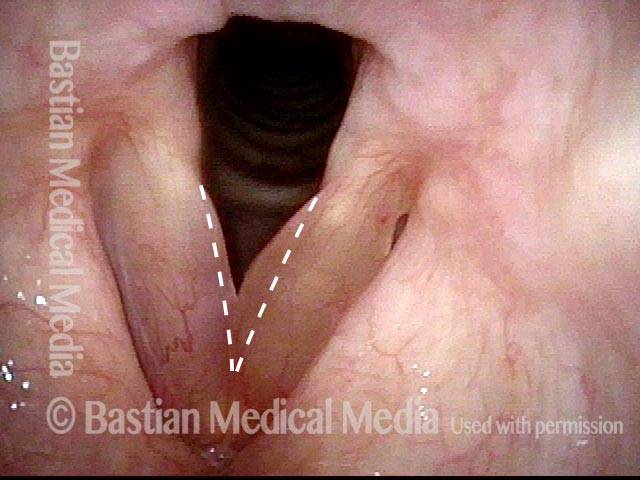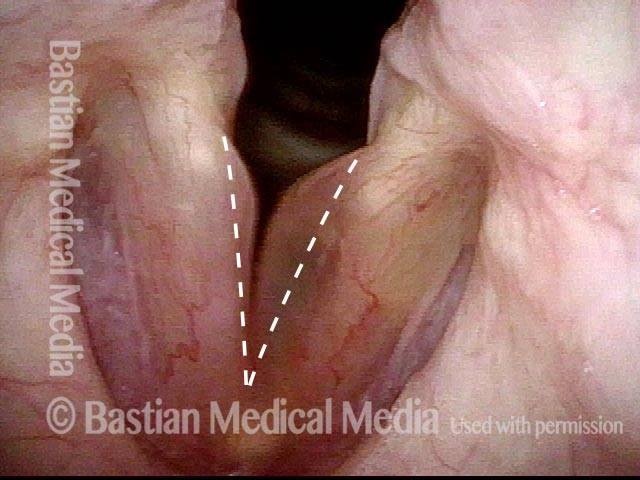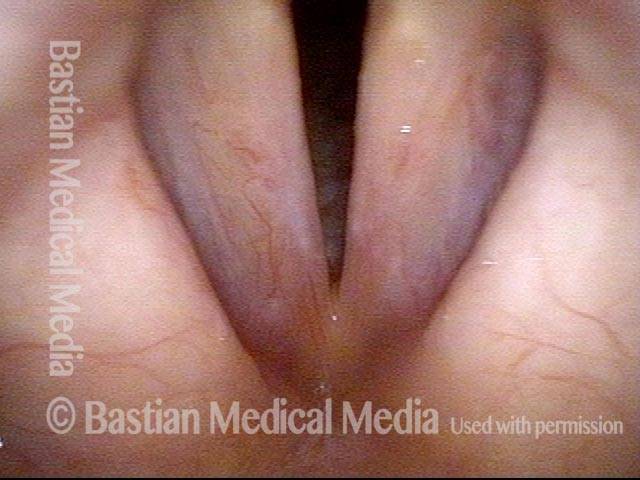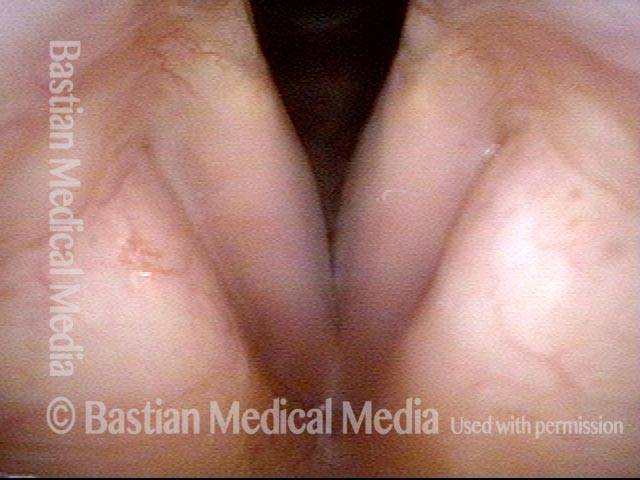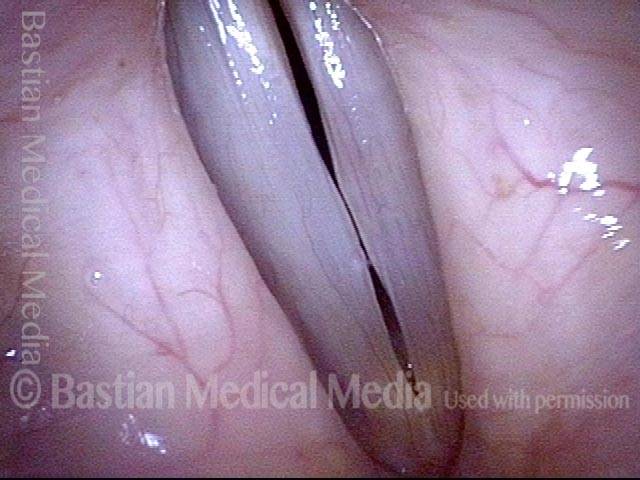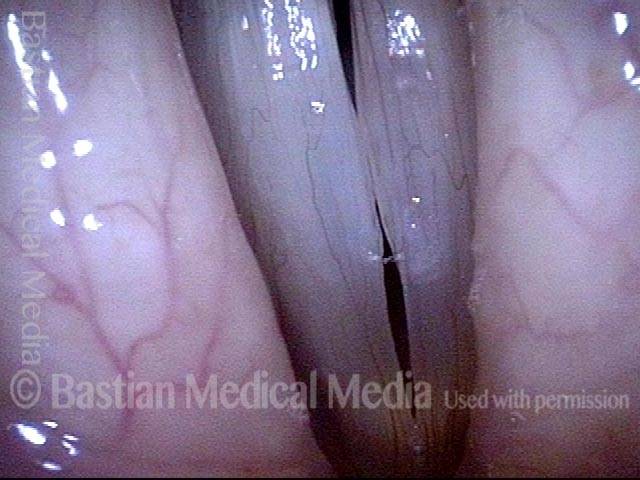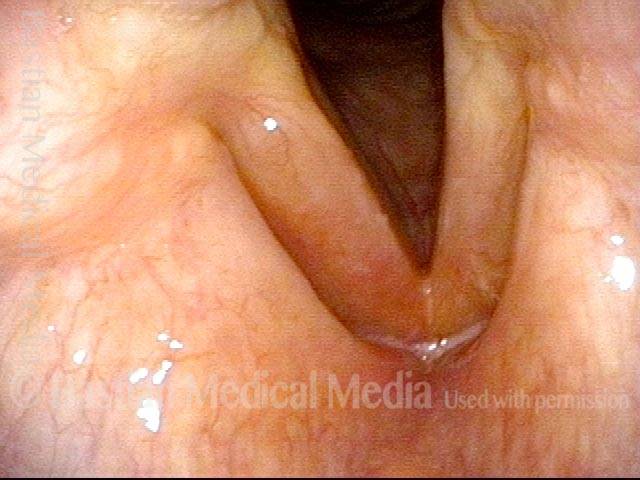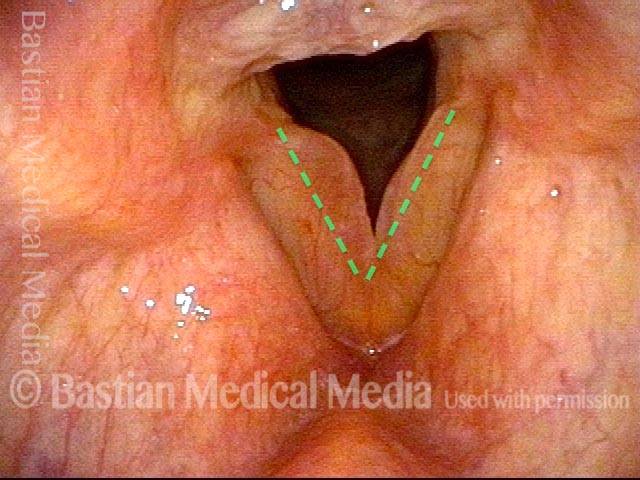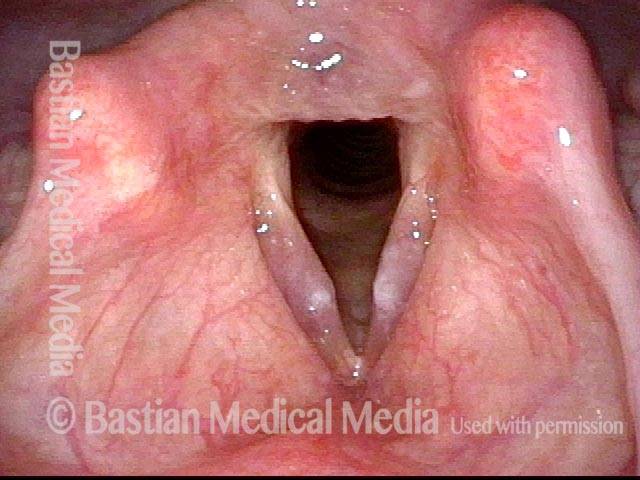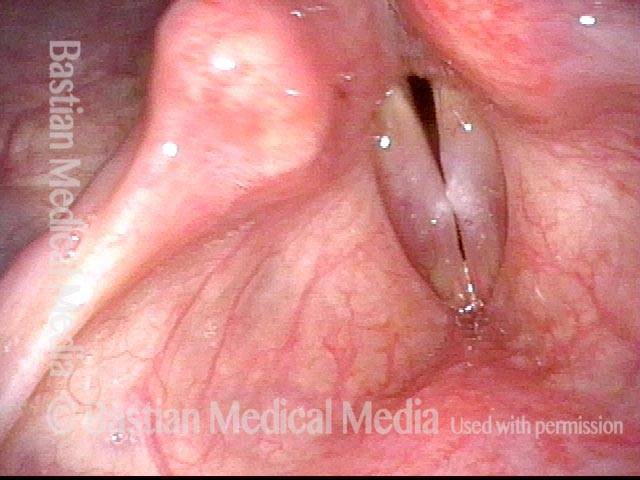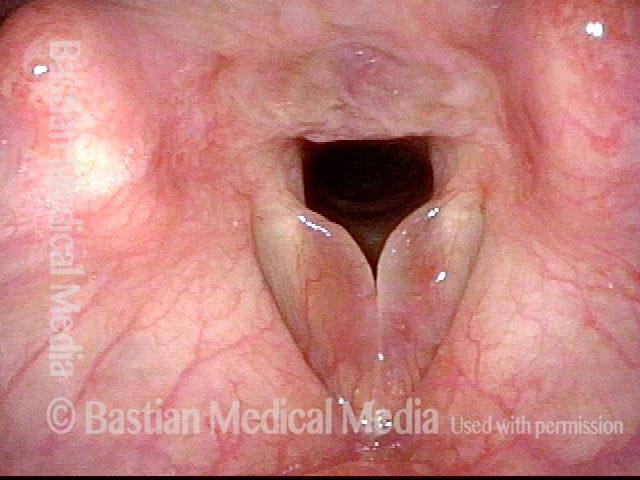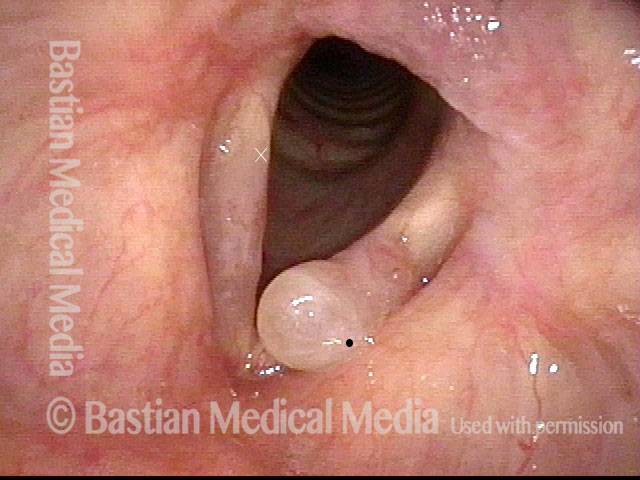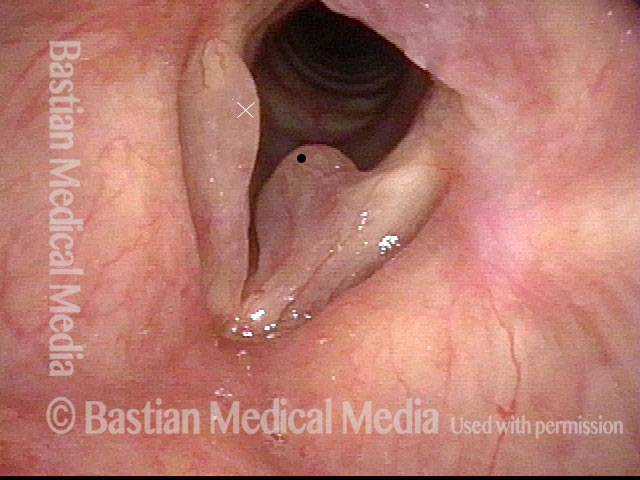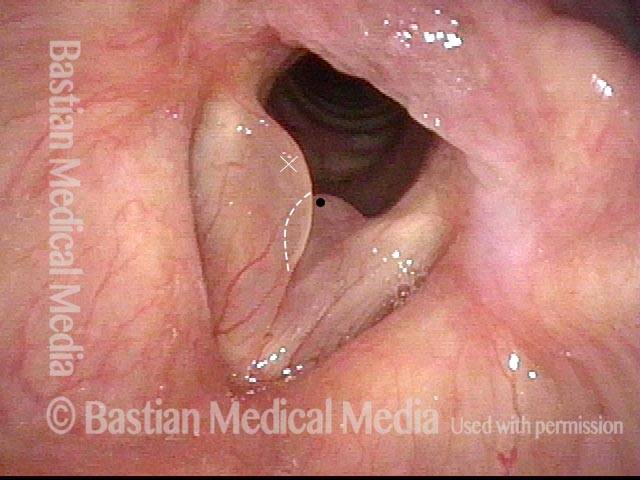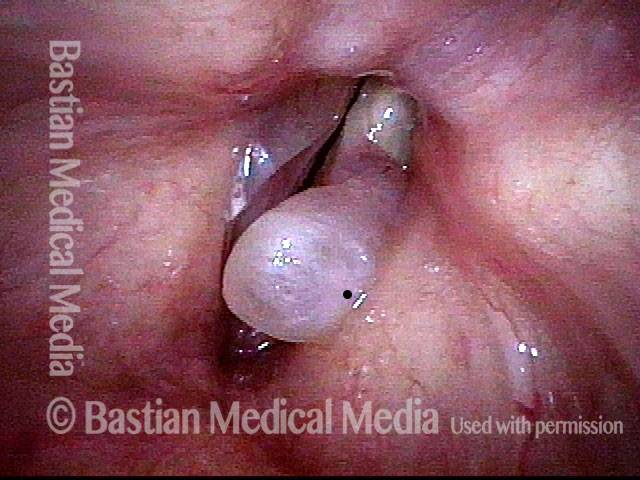Degenerazione Polipoide (Edema di Reinke, Polipi del Fumatore)
Gonfiore diffuso delle corde vocali, dovuto all’accumulo di liquido edema all’interno della mucosa. La degenerazione polipoide viene anche chiamata edema di Reinke o polipi del fumatore. Questa condizione si osserva più spesso nei fumatori di lunga data che sono anche un po’ loquaci. In altre parole, la degenerazione polipoide è rara nei non fumatori loquaci ed è rara anche nei fumatori taciturni.
Sintomi
La degenerazione polipoide tende a virilizzare (mascolinizzare) la qualità e le capacità della voce, e questo effetto è più evidente nelle donne. Inoltre, nei casi più gravi, la degenerazione polipoide può indurre una fonazione inspiratoria involontaria o un suono tremolante, quasi russante, durante l’inalazione improvvisa.
Diagnosi
La degenerazione polipoide si presenta tipicamente come sacche di liquido pallido e acquoso attaccate alla superficie superiore e ai margini delle corde vocali. Nei casi meno gravi, il gonfiore potrebbe essere più sottile, ma se al paziente viene chiesto di inspirare mentre emette la voce, il tessuto polipoide verrà allontanato dalle corde nell’apertura glottica, conferendo a ciascun margine delle corde vocali un contorno convesso e quindi diventando più evidente (vedi due esempi di questo tipo nelle foto sottostanti).
Trattamento
Il paziente viene incoraggiato a smettere di fumare. La terapia vocale a breve termine può aiutare in alcuni casi, riducendo il turgore del tessuto polipoide e migliorando così la voce in misura piccola ma evidente. Tuttavia, la stessa degenerazione polipoide è permanente, quindi se la qualità della voce rimane inaccettabile per il paziente anche dopo la terapia logopedica, è necessario un intervento chirurgico.
Per la chirurgia sulla degenerazione polipoide, una volta era comune asportare il tessuto polipoide, ma questo approccio spesso porta a una voce inaccettabilmente acuta, dal suono sottile e roca.
Un metodo migliore consiste nel ridurre il tessuto in modo più conservativo, lasciando potenzialmente una parte di tessuto polipoide residuo frazionario. In questo modo, anche se la voce potrebbe rimanere leggermente virilizzata, conserva anche una qualità più ricca e naturale.
Polipi del fumatore, prima e dopo l’intervento chirurgico (audio con foto)
Campione vocale di un paziente con polipi del fumatore, PRIMA dell’intervento chirurgico (vedere le foto di questo paziente appena sotto): Stesso paziente, due mesi DOPO l’intervento chirurgico (le occasionali interruzioni di sillabe sono dovute alla recente chirurgia):Smoker’s polyps, BEFORE surgery (1 of 4)
Smoker’s polyps, BEFORE surgery (1 of 4)
Smoker’s polyps, BEFORE surgery (2 of 4)
Smoker’s polyps, BEFORE surgery (2 of 4)
Smoker’s polyps, AFTER surgery (3 of 4)
Smoker’s polyps, AFTER surgery (3 of 4)
Smoker’s polyps, AFTER surgery (4 of 4)
Smoker’s polyps, AFTER surgery (4 of 4)
Noduli vocali polipoidi
Polypoid vocal nodules (1 of 4)
Polypoid vocal nodules (1 of 4)
Incomplete closure (2 of 4)
Incomplete closure (2 of 4)
Polypoid vocal nodules (3 of 4)
Polypoid vocal nodules (3 of 4)
Polypoid vocal nodules (4 of 4)
Polypoid vocal nodules (4 of 4)
Polipi del fumatore/Edema di Reinke
Smoker’s polyp / Reinke’s edema (1 of 2)
Smoker’s polyp / Reinke’s edema (1 of 2)
Smoker’s polyp / Reinke’s edema (2 of 2)
Smoker’s polyp / Reinke’s edema (2 of 2)
Esempio 2
Smoker’s polyps / Reinke’s edema (1 of 3)
Smoker’s polyps / Reinke’s edema (1 of 3)
Smoker’s polyps / Reinke’s edema (2 of 3)
Smoker’s polyps / Reinke’s edema (2 of 3)
Smoker’s polyps / Reinke’s edema (3 of 3)
Smoker’s polyps / Reinke’s edema (3 of 3)
Polipi del fumatore in varie “pose”
Smoker’s polyps in various “poses” (1 of 4)
Smoker’s polyps in various “poses” (1 of 4)
Polyp begins to fall off (2 of 4)
Polyp begins to fall off (2 of 4)
Polyps displace (3 of 4)
Polyps displace (3 of 4)
Edematous tissue causes a rough voice (4 of 4)
Edematous tissue causes a rough voice (4 of 4)
condividi questa pagina

Polipi del fumatore (noti anche come degenerazione polipoide o edema di Reinke)
Questo video illustra come i polipi del fumatore possano essere visti più facilmente quando il paziente emette la voce mentre inspira (detta fonazione inspiratoria). Durante la fonazione inspiratoria, i polipi vengono attirati verso l’interno e diventano più facili da identificare.
